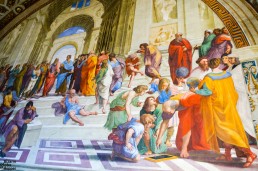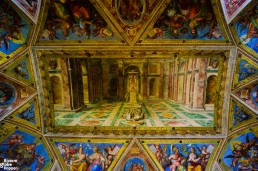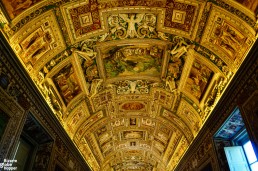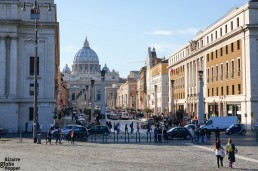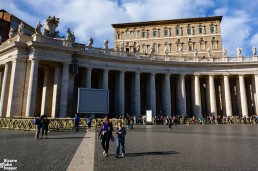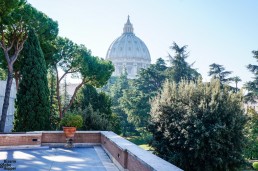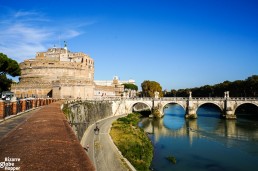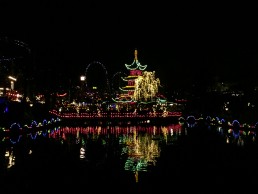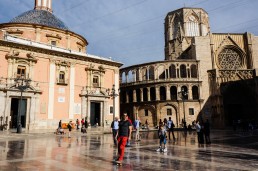Vatican is definitely one of the most bizarre places on earth. A city-state the size of a golf course has ATMs speaking Latin, mysterious secret archives, and probably the most important art collection in the world. We entered the gates of Vatican in search of the bizarre factors – and were not disappointed.
Breaking the Art Records
Quite uniquely the whole country is labeled as a Unesco World Heritage site. Impressing 9 miles of artworks are tucked into 1400 galleries inside the Vatican Museums. If you yearn to admire each artwork for just one second, you’d need five years. So pick your route carefully, if you have only a few hours to spare.
The galleries are bubbling with intriguing stories. I’ll share just a little sample here since more are featured in a separate post. After the Pope’s Master of Ceremonies called the freshly painted Sistine Chapel a brothel, Michelangelo immortalized him as one of the figures in Hell, decorated with donkey ears and tiny genitals that remain an eternal supper for a serpent. Enraged conservative appealed to the Pope, who in turn joked that his authority didn’t extend to Hell.
The Highest Crime Rate in the World
Who would have thought that visiting Vatican might be dangerous? You probably won’t face any serious crimes, but pickpockets abound. One reason is the crazy flow of tourists. As Vatican has only one judge and no prison, most criminals are simply thrown across the border back to Italy. Although there has been only one official murder inside the walls of Vatican, rumors tell about sudden deaths of some unlucky bankers.
Cocky Secret Archives
The Vatican Secret Archives, found in 1612, were opened to scholars in 1881. Over 50 miles of shelves are known to contain for example state papers and letters. Still today solely scholars may apply for the access – as a tourist, journalist or undergrad you won’t have a chance. The second catch: you need to know exactly what to ask, since browsing the Vatican Secret Archives is not possible. Some enticing samples include letters of Michelangelo and Abraham Lincoln along with transcripts of the trials against the Knights Templar and Galileo Galilei.
And then there’s this one, particularly bizarre thing. When you’ve walked around the Vatican Museums for a while, you might notice that most of the ancient statues have been castrated. All penises censored by righteous popes through the centuries are stored in the secret archives. And this is not a legend.
Intricate Money Matters
The smallest country on earth isn’t poor. It receives 70 million euros as tax-free donations each year, in addition to its other investment earnings (like the banking and stocks profits). Vatican also mints its own versions of euros with Pope’s head although it’s not even a member of the EU. Vatican’s financial matters have regularly been in the news. Last time the economy minister told that they had accidentally found hundreds of thousands of euros tucked away in the accounts of the Holy See, which coincidentally didn’t appear in any records of the city-state.
The Vatican Bank, officially named as the “Institute for the Works of Religion”, reports to the commission of the cardinals and the Pope himself. Its history is filled with secrets, scandals, and accusations of money laundering. The Vatican Bank eludes the jurisdiction of the Holy See since the assets are not its property.
Mingling the State With the Church
The terminology might be a bit confusing. For example, the ambassadors are representing the Holy See, not the Vatican city-state. Whereas the Holy See has roots in antiquity, the Vatican state was born in 1929. The Holy See is viewed as a state, and it has Vatican as its sovereign territory. Still, the Holy See is “the ecclesiastical jurisdiction of the Catholic Church in Rome” (according to Wikipedia). The government of the Holy See is called the Roman Curia, through which the Pope governs the whole Catholic Church. Speaking of the Pope: he’s also the only absolute monarch in Europe.
All this leads to a rather complex question: is the Holy See merely a church or an independent state? For example in the UN, the Holy See enjoys the same privileges as governments, unlike any other religion. Yet it exerts its religious moral code and lacks citizenry.
World’s Biggest Basilica Lacks Paintings
St. Peter’s Basilica doesn’t have any paintings – they are substituted with mosaics to ensure the artwork will endure the annual visit of more than 7 million people. St. Peter’s Square will trick your eyes even more: if you stand in a particular spot, three of four lines of the bordering columns will disappear from your sight. Thank Bernini for the brilliant illusion!
Guards Dressed Like in the Middle Ages
Don’t laugh at the funnily clad guards outside the St. Peter’s Basilica. From the 1600th century, when Pope Julius II decided that Swiss soldiers were the most reliable and loyal, all the guards of the Vatican have been required to be both Catholic and Swiss. Guards get the citizenship at the time of recruitment and lose it with the job. Design of the clown-like uniforms dates back to early 1900s. Speaking of the style: there is a dress code to enter the country, so remember to hide the flesh! Women should cover their shoulders and men can’t wear shorts.
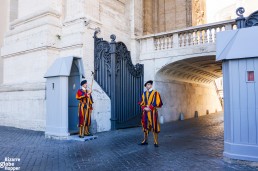
World’s Biggest Basilica Lacks Paintings
St. Peter’s Basilica doesn’t have any paintings – they are substituted with mosaics to ensure the artwork will endure the annual visit of more than 7 million people. St. Peter’s Square will trick your eyes even more: if you stand in a particular spot, three of four lines of the bordering columns will disappear from your sight. Thank Bernini for the brilliant illusion!
Guards Dressed Like in the Middle Ages
Don’t laugh at the funnily clad guards outside the St. Peter’s Basilica. From the 1600th century, when Pope Julius II decided that Swiss soldiers were the most reliable and loyal, all the guards of the Vatican have been required to be both Catholic and Swiss. Guards get the citizenship at the time of recruitment and lose it with the job. The design of the clown-like uniforms dates back to the early 1900s. Speaking of the style: there is a dress code to enter the country, so remember to hide the flesh! Women should cover their shoulders and men can’t wear shorts.
Escape Vatican Like the Popes
When you’re puzzled enough, follow an example of the bygone popes and escape outside the Vatican walls to the Castel del St. Angelo. It has almost as bizarre history as the city-state: originally Hadrianus build it as a mausoleum for himself. Later on, popes have used it as a castle and a prison. When things heated up, popes used to escape through a secret passage connecting the St. Peter’s and the Castel del St. Angelo. For example, during the sacking of Rome, the passage saved the pope of the moment, Clement VII when almost all of his Swiss Guards were executed at St. Peter’s. As a curiosity, he still ended up imprisoned in the Castel del St. Angelo for six months.
From a scale of 1 to 10, how weird you hold up this walled enclave? Have you heard any strange stories about Vatican? Feel free to share them with us, the more bizarre – the better!
Pin this story!
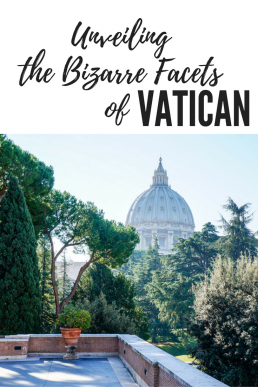
You May Also Like to Read:
Hunting the Art Treasures And Ghosts of Vatican
The grounds of the Vatican Museums have witnessed papal conspiracies, a ferocious ambition of rivaling artists, and loads of dark secrets. Feel the presence of Michelangelo, the Borgia Pope and other anxious souls still searching for their atonement.
Best Christmas Markets in Copenhagen and Christmas Things to Do
Wander through Copenhagen’s Christmas markets, marvel Tivoli in its Christmas gown and sip Danish winter brews to catch the spirit of Yule.
Valencia’s Old Town Merges Famous Sights With Street Art
Narrow alleys of El Carmen host a weird mix: subcultures and street art, orange gardens, old mansions, and the most iconic sights of the city.


